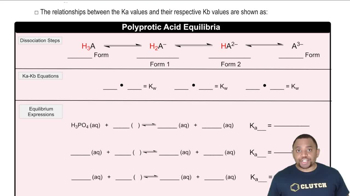Here are the essential concepts you must grasp in order to answer the question correctly.
Triprotic Acids
Triprotic acids, like H3PO4 (phosphoric acid), can donate three protons (H+) in a stepwise manner. Each dissociation step results in a different anion and a corresponding equilibrium constant. Understanding the nature of triprotic acids is essential for writing their dissociation equations and predicting the behavior of the resulting species in solution.
Recommended video:
Triprotic Acid Equilibrium
Net Ionic Equations
Net ionic equations represent the actual chemical species involved in a reaction, excluding spectator ions. For the dissociation of acids, this means focusing on the ions produced when the acid donates protons. Writing balanced net ionic equations is crucial for accurately depicting the chemical changes occurring in solution.
Recommended video:
Equilibrium Constants
Equilibrium constants (K) quantify the ratio of products to reactants at equilibrium for a given reaction. For each step of a triprotic acid's dissociation, there is a corresponding equilibrium constant (K1, K2, K3) that reflects the strength of the acid at each dissociation stage. Understanding these constants helps in predicting the extent of dissociation and the concentrations of species in solution.
Recommended video:

 Verified step by step guidance
Verified step by step guidance


